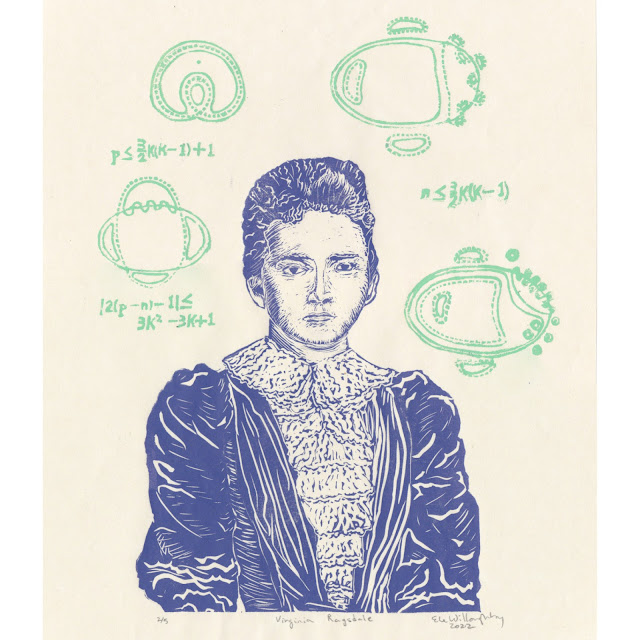 |
| Virginia Ragsdale, linocut, 11" x 14" on cream coloured washi, by Ele Willoughby, 2022 |
One of the unexpected delights of making a series of portraits of people in STEM is that people are interested in subjects because of their personal relationships. In hindsight, it should have been obvious; I am a scientist and have family and friends! But, it didn't occur to me that these "famous" (in some circle) great scientists would appeal as images of family members, or friends, and it's actually pretty touching when people contact me and tell me they are buying a print because the subject is someone they knew personally. This is a mathematician who was introduced to me by a repeat customer, because this is one of her ancestors. So not only to I get to learn of a new-to-me historic women in STEM, but I have a commission to make her portrait for someone's own personal connection to her.
This is a linocut portrait of mathematician Virginia Ragsdale (1870-1945) who is remembered for the Ragsdale conjecture (shown in the upper two inequalities). I'm always wary of including equations in talking about the history of math and science. What's important is that she proposed a way of approaching a difficult problem that was an inspiration for a lot of other mathematicians. The problem (which remains unsolved!) was included in David Hilbert's famous set of problems, namely, what are the possible arrangements of real algebraic curves embedded in the projective plane? She decided to set an upper bound for certain type of such curves. She proposed that they consider algebraic curve of degree 2k which are all topologically circles (or ovals) where some ovals are nested inside each other; others are not. An oval is defined as even if it is contained an an even number of other ovals of the curve, otherwise the oval is called odd. She conjectured that for an algebraic curve which contains p odd and n even ovals:
.
It was a very useful insight to consider even and odd ovals separately; the difference p-n is the Euler characteristic of a region bounded by the even and odd ovals. The Ragsdale conjecture, made in her 1906 dissertation, is amongst the earliest and most famous on the topology of real and algebraic curves, which stimulated a lot of 20th century research and was not disproved until 1979. A correct upper bound has yet to be found. I have also included an inequality she posed:
later proved by Ivan Petrovsky. The diagrams of algebraic curves also appeared in her dissertation "On the Arrangement of the Real Branches of Plane Algebraic Curves," was published by the American Journal of Mathematics in 1906. In it she tackles the 16th of David Hilbert’s famous 23 unsolved problems in mathematics - one of only a few which remain unresolved today.
Born in Jamestown, North Carolina just after the Civil War, she was class valedictorian at the Salem Academy, where she excelled at math and piano. She was went on to Guilford College where she helped set up a YMCA, and establish an Alumni Association as well and worked to expand college athletics. When she graduated with a B.S. in 1892, she won a scholarship to Bryn Mawr for the woman student with the highest grades, so she continued on, studying for her A.B. degree in physics. She won a fellowship to study in Europe for the class of 1896, which she delayed for a year, working as a physics demonstrator and beginning graduate studies in math. She then spent 1897-98 attending lectures by the renown mathematicians Felix Klein and David Hilbert at the University of Göttingen.
Upon returning the the US, she taught math for three years in Baltimore before another scholarship, awarded by the Baltimore Association for the Promotion of University Education of Women, allowed her to return to Bryn Mawr to complete her doctorate with Charlotte Scott.
She moved to New York and taught at Dr. Sach’s School for Girls until 1905. She became the head of the Baldwin School in Bryn Mawr from 1906-1911 and worked as Charlotte Scott’s reader from 1908-1910. She accepted a mathematics position which brought her back to North Carolina in 1911 at the Women’s College in Greensboro (now UNC at Greensboro) where she stayed for almost two decades. She was department head from 1926-1928 and left a lasting impact, insisting on investing in a telescope and adding statistics to the curriculum. She held high standards but was known for her patience for students.
She retired to care for her ailing mother and run the family farm in 1928. When her mother died she built a lovely house at the edge of the Guilford College where she gardened, restored furniture and researched her family’s genealogy. Upon her death she left the home to the college and serves now as the home of the college president.
References









No comments:
Post a Comment